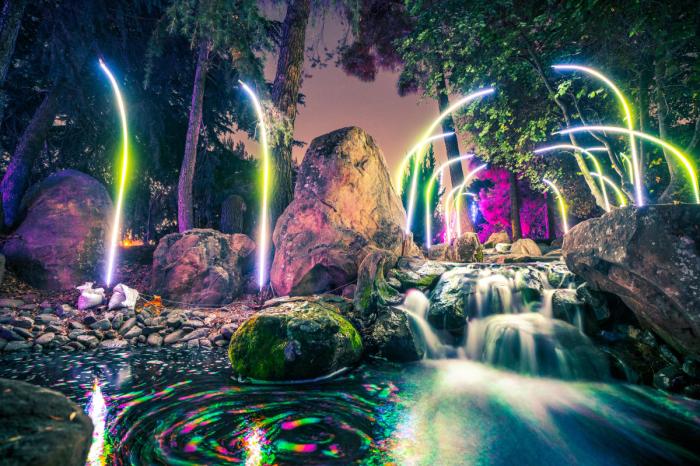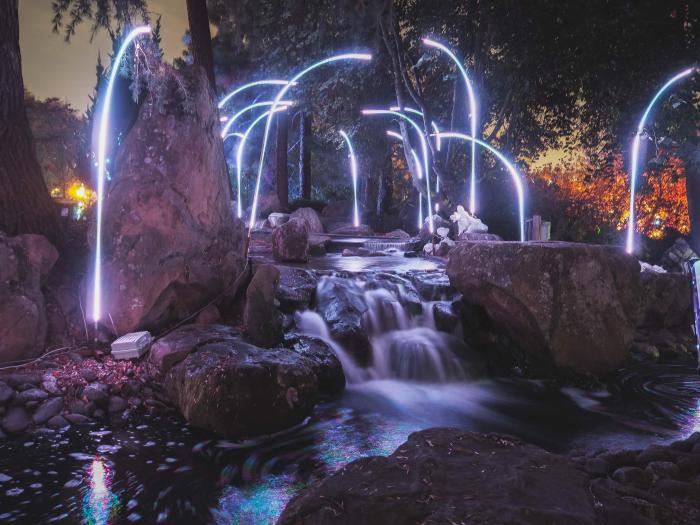Autumn Lights Festival: Imagine a breathtaking spectacle of vibrant colors and dazzling light displays transforming the night into a magical wonderland. From intricate LED installations to mesmerizing projections, these festivals offer a captivating blend of artistry, technology, and community spirit. This immersive experience draws in families, friends, and anyone seeking a unique autumnal adventure, creating lasting memories through interactive activities, delicious food, and unforgettable moments.
These festivals are more than just pretty lights; they’re meticulously planned events requiring detailed logistics, innovative lighting design, and effective marketing strategies to attract large crowds. Understanding the target audience, managing event logistics, and creating a memorable atmosphere are crucial for success. We’ll delve into the key aspects of creating a spectacular Autumn Lights Festival, from initial planning to post-event analysis.
Target Audience & Marketing

Autumn Lights Festivals offer a unique blend of entertainment and seasonal charm, attracting a diverse audience. Understanding this audience is crucial for crafting effective marketing strategies that maximize attendance and generate positive word-of-mouth. By focusing on specific demographics and tailoring our messaging, we can significantly improve the festival’s overall success.Successfully marketing an Autumn Lights Festival requires a multi-pronged approach, focusing on the key demographic groups most likely to attend and leveraging various marketing channels to reach them effectively.
A well-defined marketing plan will not only drive ticket sales but also cultivate a loyal following for future events.
Primary Demographic Groups
The primary demographic groups attracted to Autumn Lights Festivals are families with young children, couples seeking romantic outings, and groups of friends looking for festive experiences. Families are drawn to the enchanting atmosphere, photo opportunities, and often family-friendly activities like pumpkin patches or craft booths. Couples appreciate the romantic ambiance, while friend groups enjoy the social aspect and shared experience.
Secondary demographics may include older adults who enjoy the visual spectacle and community events, and tourists seeking local seasonal attractions. Understanding these diverse motivations is critical for effective marketing.
Marketing Campaign Targeting Families with Young Children
A marketing campaign targeting families with young children should emphasize the family-friendly aspects of the festival. This could involve showcasing images and videos of children enjoying the lights, highlighting family-friendly activities like face painting or carousel rides, and emphasizing the safety and accessibility of the festival grounds. Promotional materials should use bright, cheerful colors and imagery that appeals to children.
Consider partnering with local family-focused businesses or organizations for cross-promotion and distribution of flyers in relevant locations such as schools, libraries, and community centers. Offering family discounts or special packages can further incentivize family attendance. Consider running targeted ads on platforms like Facebook and Instagram, focusing on parents of young children in the local area.
Social Media Strategy for Promoting an Autumn Lights Festival
A robust social media strategy is essential for reaching a broad audience and building excitement for the festival. Utilize platforms like Instagram, Facebook, and TikTok to showcase visually appealing content, including high-quality photos and videos of the lights, behind-the-scenes glimpses of the festival preparations, and user-generated content from previous years. Run contests and giveaways to encourage engagement and build anticipation.
Partner with local influencers who have a strong family-oriented following to promote the festival to their audience. Utilize targeted advertising to reach specific demographics based on location, age, and interests. Regularly post updates about the festival schedule, ticket sales, and special events. Monitor social media for feedback and address any concerns promptly. A strong hashtag campaign can help consolidate all related content and increase visibility.
Marketing Strategies for Different Festival Locations
Marketing strategies should be adapted to the specific location of the festival. A festival in a large metropolitan area might require a more extensive digital marketing campaign targeting a wider audience, whereas a festival in a smaller town might benefit from a more localized approach, utilizing print media, community partnerships, and word-of-mouth marketing. Consider the local competition and adjust your messaging accordingly.
For example, a festival in a rural area might emphasize the unique charm and escape from city life, while a festival in a bustling city might highlight the convenience and accessibility of its location. Analyzing local demographics and media consumption habits is vital for tailoring the marketing approach to each specific location. For example, a festival near a university might target students with special offers and promotions.
Lighting Design & Technology: Autumn Lights Festival

Autumn Lights Festivals rely heavily on captivating lighting displays to transform outdoor spaces into immersive experiences. The strategic use of diverse lighting technologies is paramount to achieving the desired ambiance, ensuring visitor safety, and maximizing the overall impact of the event. Effective lighting design balances artistic expression with practical considerations, resulting in a memorable and engaging festival atmosphere.
The success of any Autumn Lights Festival hinges on the seamless integration of various lighting technologies. This involves careful planning, precise execution, and a deep understanding of the unique challenges presented by outdoor environments. From energy efficiency to creative illumination, each element contributes to the overall visitor experience.
Lighting Technologies Employed in Autumn Lights Festivals
Autumn Lights Festivals typically utilize a blend of lighting technologies to achieve diverse effects. LEDs (Light Emitting Diodes) are a cornerstone, offering energy efficiency, vibrant color options, and long lifespans. Their versatility allows for everything from subtle ambient lighting to dramatic spotlighting of key features. Projection mapping, another significant technology, transforms buildings, trees, and other structures into dynamic canvases for captivating visuals.
Laser displays add a spectacle element, projecting intricate patterns and beams across large areas. Finally, traditional lighting elements, such as strategically placed spotlights and floodlights, provide essential illumination for walkways and safety purposes.
Challenges of Outdoor Lighting Design
Designing lighting for outdoor festivals presents unique hurdles. Unpredictable weather conditions, such as rain, wind, and fog, can significantly impact lighting visibility and functionality. The vastness of outdoor spaces requires careful consideration of light distribution and spill, to avoid light pollution and ensure optimal illumination of designated areas. Power supply and accessibility in outdoor locations often pose logistical challenges, demanding creative solutions for cable management and power distribution.
Safety is paramount; lighting design must prioritize clear pathways and minimize potential hazards. Finally, maintaining a balance between vibrant illumination and preserving the natural beauty of the surrounding environment is crucial. For instance, excessive brightness could overwhelm the natural autumnal colors.
Innovative Lighting Techniques for Enhanced Festival Experience
Innovative lighting techniques significantly enhance the festival experience. Interactive lighting installations, responding to audience movement or sound, create dynamic and engaging environments. The use of color-changing LEDs synchronized with music or themed events can create immersive experiences, transforming the atmosphere in real-time. Projection mapping on natural elements, such as trees or water features, adds a layer of magic and surprise, blending technology with the natural beauty of the season.
Consider, for example, a projection mapping display transforming the leaves of towering trees into a vibrant autumnal kaleidoscope. Another example could be interactive light sculptures responding to touch, adding a playful element to the experience.
Comparison of Lighting Solutions
| Lighting Type | Energy Efficiency | Cost | Advantages |
|---|---|---|---|
| LEDs | High (up to 80% energy savings compared to incandescent) | Medium to High (initial investment, but lower running costs) | Long lifespan, vibrant colors, energy efficient, low maintenance |
| Projection Mapping | Medium (depends on projector type and usage) | High (initial investment in projectors and software) | Creates immersive visuals, transforms surfaces, high impact |
| Laser Displays | High (relatively low energy consumption for high output) | High (specialized equipment and skilled operators required) | Spectacular visuals, long-range projection capabilities, unique effects |
| Traditional Lighting (Halogen/Incandescent) | Low | Low (initial cost, but high running costs) | Simple to implement, readily available, but becoming obsolete due to inefficiency. |
Ultimately, a successful Autumn Lights Festival hinges on a perfect blend of creative lighting design, meticulous logistical planning, and a captivating marketing campaign. By carefully considering the target audience, incorporating innovative lighting technologies, and managing all operational aspects effectively, event organizers can create an unforgettable experience for attendees and establish a highly anticipated annual tradition. The vibrant atmosphere, combined with the unique visual spectacle, creates a powerful draw, solidifying the Autumn Lights Festival as a must-see autumn event.